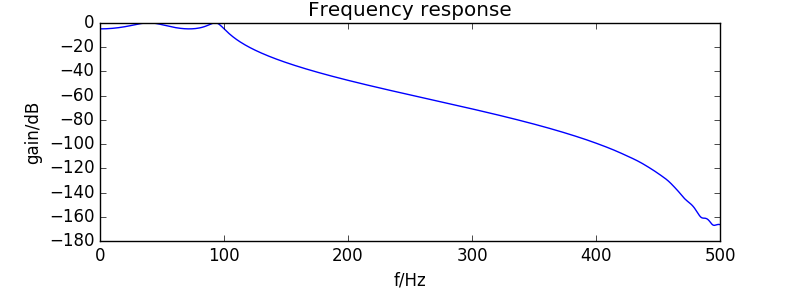A powerful C++ filter library for Linux, Mac OSX and Windows which implements all standard IIR filters such as Bessel, Butterworth, RBJ and Chebychev (which is shown above).
The filter accepts both float and double numbers which are automatically converted to the internal representation which is double.
There is no need to resort to MATLAB/OCTAVE/Python to calculate the filter coefficients because the library does it by itself. Just provide the sampling rate, cutoff frequency, filter order and the filter is ready to be used. For example for a lowpass:
Usage is straightforward: first the filter parameters are set and then it's ready to be used for sample by sample realtime filtering.
#define order 4
Iir::Butterworth::LowPass<order> f;
const float samplingrate = 1000; // Hz
const float cutoff_frequency = 5; // Hz
f.setup (order, samplingrate, cutoff_frequency);
float y = f.filter(x);
If you have Ubuntu xenial, artful or bionic then install it as a pre-compiled package:
sudo add-apt-repository ppa:berndporr/usbdux
The build tool is cmake which generates the make- or project
files for the different platforms. cmake is available for Linux, Windows
and Mac.
Run
cmake -DCMAKE_BUILD_TYPE=Release .
which generates the Makefile. Then run:
make
sudo make install
which installs it under /usr/local/lib and /usr/local/include.
cmake -G "Visual Studio 15 2017 Win64" .
See cmake for the different build-options. Above is for a 64 bit build.
Then start Visual C++ and open the solution. This will create
the DLL and the LIB files.
Run unit tests by typing make test or just ctest.
These test if after a delta pulse all filters relax to zero and
that their outputs never become NaN.
The easiest way to learn is from the examples which are in the demo
directory. A delta pulse as a test signal is sent into the different
filters and saved as a file. With the Python script
plot_impulse_fresponse.py you can then plot the frequency responses.
Also the directory containing the unit tests provides examples for every filter type.
For an overview of the class structure and general concepts have a look at Documentation.txt.
Run doxygen to generate the documented class hierachy on the basis of
the comments in the header files. The file format is HTML and will be
stored in the doc subdirectory.
This library has been adapted form Vinnie Falco's original work which can be found here: https://github.com/vinniefalco/DSPFilters
Enjoy!
Bernd Porr
